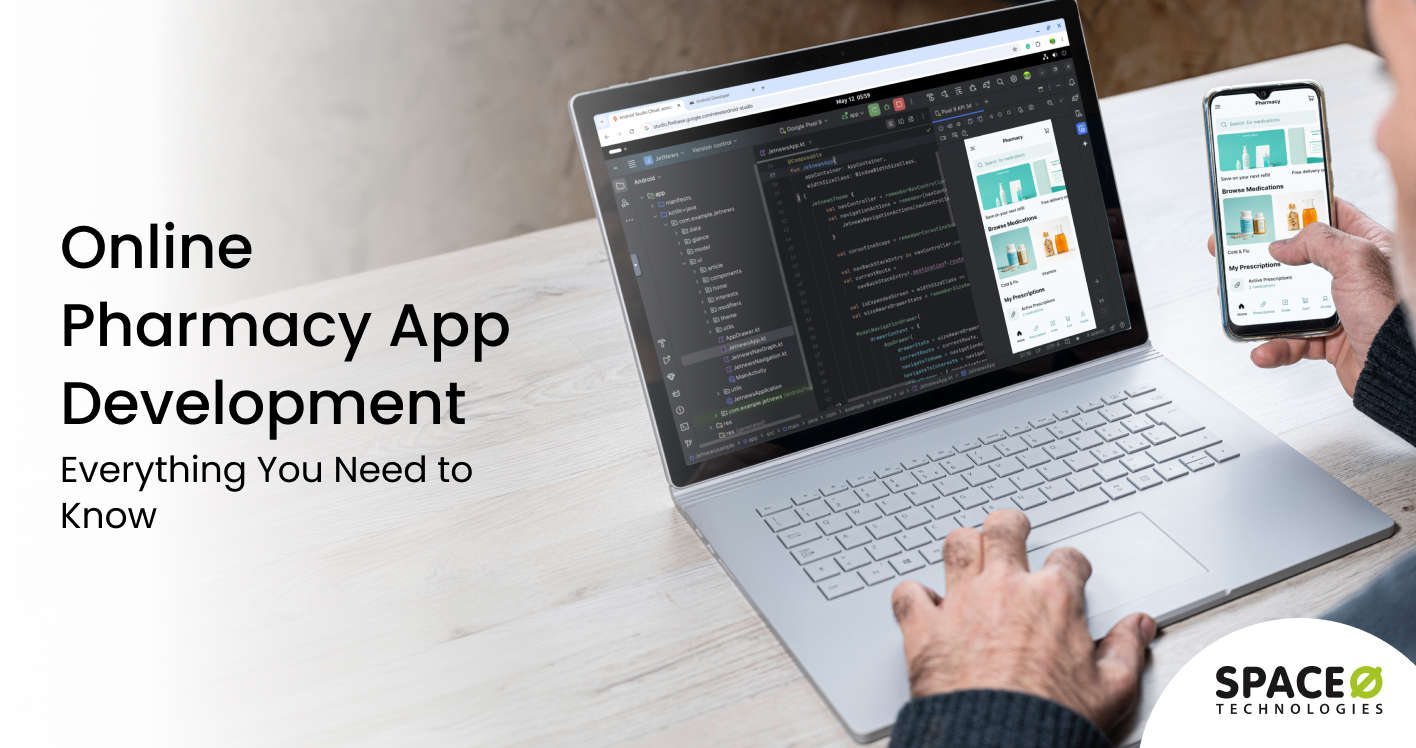Contents
Are you a pharmacy owner, healthcare startup, or entrepreneur looking to tap into the rapidly growing digital healthcare market? Wondering how to launch a medicine delivery app that stands out in a crowded marketplace?
With more people preferring home delivery of medicines for convenience and safety, building a robust app has become a top priority for businesses looking to expand their reach and improve customer experience.
The on-demand pharmacy market is accelerating worldwide. This shift is driven by shifting consumer expectations, increased smartphone usage, and the growing demand for convenient, timely access to medicines.
A well-designed medicine delivery app not only enables doorstep delivery but also streamlines operations, ensures regulatory compliance, and boosts customer loyalty.
This blog explores everything you need to know about medicine delivery app development, from understanding what a medicine delivery app is to why investing in one can transform your business. Explore the essential features, the step-by-step development process, and the expected development costs of medicine apps to build a successful solution.
What Is a Medicine Delivery App?
A medicine delivery app is a mobile platform that allows users to order prescription and over-the-counter medicines online and have them delivered to their doorstep. These apps connect pharmacies, healthcare providers, and customers on a single digital platform, making access to medicines faster, safer, and more convenient.
From uploading a doctor’s prescription to tracking deliveries in real time, these apps streamline the entire pharmacy experience. Users can search for medicines, compare prices, schedule refills, make secure payments, and receive 24/7 delivery support, all within a few taps.
For businesses, a medicine delivery app serves as a digital extension of their pharmacy operations. It helps expand reach beyond physical stores, improve order management, and enhance customer loyalty through personalized offers and timely service.
In short, working with a pharmacy app development company and building a medicine delivery app bridges the gap between patients in need of timely medications and pharmacies ready to serve them. It transforms the traditional pharmacy model into a convenient, on-demand digital healthcare experience.
[Did You Know]
As per Verified Market Research, the global pharmacy delivery app market size is currently estimated at USD 4 billion for 2024. This figure is estimated to reach USD 12.5 billion by 2033. This growth highlights the growing scope of digital medicine delivery apps.
Once you understand the basic concept, the next step is choosing the right business model for your venture. Different models suit different business goals and investment capacities.
Three Core Medicine Delivery App Models
Choosing the right business model determines your investment, operational complexity, and profit potential. Each model has unique advantages depending on your resources and business goals. Let’s explore the three main approaches.
Pharmacy aggregator model
This works like Uber for medicines, where the app connects users with multiple local pharmacies. Users compare prices and choose their preferred pharmacy, while the app takes a commission on each order.
This model requires minimal inventory investment since you focus on building the platform and user base while pharmacies handle stock and fulfillment.
Inventory-based model
Here, you own the medicines and manage warehouses, stock inventory, and handle deliveries directly. This gives you complete control over quality and delivery times. The trade-off is higher upfront investment and operational complexity, but profit margins can be better.
Hybrid model
This combines both approaches, where you maintain some inventory for fast-moving items while partnering with local pharmacies for specialized medicines. This balanced approach offers flexibility and lets you scale gradually while maintaining quality control.
To help you choose the right model, here’s a quick comparison of each approach based on key factors:
Model Type Best For Investment Level Control Aggregator Startups, quick launch Low Medium Inventory-Based Pharmacy chains High Full Hybrid Growing businesses Medium High Now that you understand what medicine delivery apps are and the business models available, let’s examine why developing a medicine delivery app is a great idea.
Why Invest In Medicine Delivery App Development?
Current trends, user behavior shifts, and technological advancements are creating unprecedented opportunities in the online pharmacy space. Here are the benefits of developing a medicine delivery app:
Expands geographic reach
Physical pharmacies serve limited areas, but an online medicine delivery app breaks those boundaries. You can serve customers across entire cities or even countries with one platform and exponential reach.
Enables 24/7 revenue generation
Your app doesn’t sleep, so customers can order anytime, whether it’s 2 PM or 2 AM. This round-the-clock availability increases order volumes significantly through night shift workers, parents with sick children, and elderly patients needing urgent refills.
Reduce operational costs
Digital operations cost less than maintaining multiple physical stores. No rent for numerous locations, fewer staff requirements, and lower overhead expenses mean the savings are substantial and can be invested in better delivery, customer service, or app improvements.
Provides data-driven insights
Every user interaction generates valuable data that shows you what medicines are in demand, which areas have the most orders, and what times people order most frequently. These insights help optimize inventory, reduce waste, and plan better promotions.
Optimizes operational efficiency
Medicine delivery apps help streamline pharmacy operations by automating inventory management, order processing, and logistics. This reduces manual errors, saves time, and ensures that pharmacies can handle higher volumes of orders without compromising accuracy or service quality.
Drives customer loyalty
Convenience is at the heart of user satisfaction. Features like doorstep delivery, real-time order tracking, and automated refill reminders keep customers engaged and coming back for repeat purchases, fostering stronger relationships and boosting retention rates.
The market opportunity is clear, and customer demand is proven. But to develop an online medicine delivery app, it is important to know how such apps work.
Build Your Own Medicine Delivery App Today
Partner with Space-O Technologies to create a secure, scalable, and high-performing pharmacy delivery app tailored to your business model. From UI/UX to compliance, we handle it all.

How Medicine Delivery Apps Work
Medicine delivery apps simplify the process of purchasing and receiving medicines by connecting users, pharmacies, and delivery personnel on a single platform. Here’s a step-by-step look at how these apps function:
User Places an Order
The process begins when a customer logs into the app and searches for the required medicine. Users can:
- Browse the medicine catalog by category or brand
- Upload prescriptions for verification (mandatory for prescription drugs)
- Add medicines to the cart and schedule delivery
The app may also offer features like order history, repeat orders, and price comparison to enhance convenience.
Prescription Verification
For prescription medicines, the app verifies the uploaded prescription. This can involve:
- Automated verification using AI-based systems (optional)
- Manual verification by the pharmacy staff
- Ensuring compliance with regulatory requirements to maintain legality and safety
Pharmacy Confirms the Order
Once the prescription is verified, the pharmacy receives the order details, including:
- Medicines requested
- Quantity and dosage
- Delivery address and schedule
The pharmacy checks inventory, confirms availability, and updates the app so the user can track the status.
Payment Processing
Payment can be completed via multiple secure options:
- Credit/debit cards or net banking
- UPI or mobile wallets
- Cash on delivery (if supported)
Most apps also provide digital receipts and payment confirmations to maintain transparency.
Order Dispatch and Delivery
After payment confirmation:
- The pharmacy prepares the order
- A delivery partner is assigned via the app’s logistics module
- The user receives real-time updates and can track the delivery status
This ensures timely and efficient delivery, often within the same day or a scheduled time slot.
Post-Delivery Services
Good medicine delivery apps offer:
- Delivery confirmation and notifications
- Feedback or rating system for pharmacies and delivery partners
- Refill reminders for recurring prescriptions
- Customer support for returns, delays, or queries
By streamlining every step, medicine delivery apps make the process fast, convenient, and reliable. They also help pharmacies manage orders efficiently and provide valuable data insights to improve service quality. Next, let’s understand the features and functionalities that help a medicine delivery mobile application operate.
Essential Features Your Medicine Delivery Application Needs
When planning to build a medicine delivery app, it is important to balance functionality with simplicity. A medicine app has three key users:
- The end users using the app to purchase medicines
- Pharmacies listing their products on the platform
- Delivery partners that fulfill the orders
Here are the key features for each of these roles:
User app features
The patient-facing app is your primary revenue driver. This platform will be used by your end users to purchase medicines. Every feature here directly impacts user satisfaction, order completion rates, and repeat purchases.
Smart user registration
Make onboarding effortless with flexible signup options, such as email, phone number, or social media. For returning users, integrate biometric authentication such as Face ID or fingerprint unlock for fast and secure access. The easier the login, the faster users can start ordering.
Powerful medicine search
Enable users to quickly find what they need through intelligent search by name, category, or health condition. Add filters for brand, generic alternatives, and price ranges. Auto-suggestions and related medicine recommendations help users make informed choices effortlessly.
Upload prescriptions
Allow users to upload prescriptions in multiple formats, such as photos, PDFs, or digital copies. Use AI-powered OCR to automatically extract medicine names and details, minimizing manual entry and speeding up order verification.
Seamless ordering process
Ensure a simple, transparent checkout flow: add to cart, review, and pay without hidden charges. If a medicine is out of stock, suggest substitutes instead of showing “unavailable.” This not only improves conversion rates but also builds trust.
Multiple payment options
Offer a range of secure payment modes, including credit/debit cards, UPI, wallets, net banking, and cash on delivery. More payment choices reduce cart abandonment and cater to varied customer preferences.
Real-time order tracking
Give users complete visibility into their order journey, from prescription verification to packaging, dispatch, and delivery. Live GPS tracking lets them see exactly where their delivery is, ensuring transparency and trust.
Smart medication reminders
Help users stay consistent with automated reminders for medication times and refill alerts. This feature is especially valuable for chronic disease patients and improves long-term app engagement.
Complete order history
Display all past orders, prescriptions, and payments in one place. With one-tap reordering, users can quickly repurchase regular medicines, boosting retention and lifetime value.
Pharmacy panel features
Pharmacies are your fulfillment partners, and their efficiency directly affects customer satisfaction. A well-designed pharmacy panel streamlines operations, reduces errors, and helps partners manage inventory and orders effectively.
Real-time inventory management
Automatically track stock levels, expiry dates, and low-inventory alerts. Integration with existing pharmacy management systems ensures accuracy and prevents stockouts of essential medicines.
Efficient order management
Provide a clean dashboard showing all orders: pending, processing, packed, and dispatched. Enable quick actions like accept, reject, or suggest alternatives to maintain fast turnaround times.
Prescription verification tools
Allow pharmacists to review uploaded prescriptions easily using zoom, rotate, and enhance options. Verification logs help maintain regulatory compliance and ensure transparency.
Sales analytics and tends
Offer data-driven insights, such as top-selling medicines, high-demand areas, and peak order times. These analytics help pharmacies optimize inventory, staffing, and promotions.
Delivery partner app features
Fast, reliable delivery is what separates great apps from mediocre ones. Your delivery partners need tools that make their job easier, routes clearer, and earnings transparent.
Simple order management
Display all available orders with pickup and delivery details. Allow drivers to accept or reject deliveries based on location or time, improving efficiency and satisfaction.
GPS navigation
Use real-time maps with traffic updates to optimize delivery routes. Multi-order routing helps drivers handle several deliveries efficiently, reducing time and fuel costs.
Delivery status updates
One-tap status updates, such as picked up, on the way, delivered, keep customers, pharmacies, and support teams informed. A simple interface ensures ease of use on the go.
Earnings tracking
Give drivers full visibility into their earnings, including daily, weekly, and monthly income. Include digital payment tracking and transparent commission details to build trust and motivation.
With core features defined, you’re ready to think bigger. Advanced features create competitive advantages that basic apps simply can’t match.
Build a Feature-Rich Medicine Delivery App with Our Experts
From intuitive patient interfaces to powerful pharmacy and delivery dashboards, our team can help you build a complete medicine delivery solution that delights users and drives revenue.
Advanced Features That Give Your Medicine Delivery App a Competitive Edge
Basic features get you into the game, but advanced features help you win it. These cutting-edge capabilities create competitive moats, increase user engagement, and open new revenue streams that basic apps simply can’t access.
AI-powered smart recommendations
Machine learning analyzes user behavior to suggest relevant medicines and health products, increasing average order value. Someone buying diabetes medication gets recommendations for glucose meters or diabetic-friendly foods.
24/7 AI chatbot support
AI chatbots handle routine queries about medicine availability, order status, and delivery time instantly while escalating complex issues to humans. This creates a support system that scales without proportionally increasing costs.
Telemedicine integration
Let users consult doctors through video calls, get e-prescriptions directly, and order medicines immediately. This integration removes prescription friction and positions your platform as a comprehensive health solution.
Subscription services for chronic patients
Auto-refills for chronic conditions like diabetes and hypertension guarantee recurring revenue while solving real problems. Patients never run out of essential medications, ensuring adherence and peace of mind.
Lab test bookings
Partner with diagnostic labs for test bookings with home sample collection and digital reports. This creates another revenue stream while increasing app engagement significantly.
Voice search capability
Voice commands like “Find paracetamol tablets” make ordering easier for elderly users and those with accessibility needs. This technology removes typing barriers and expands your user base.
Having learned the must-have as well as advanced features a powerful medicine delivery app should include, it’s time we take a quick look at the cost breakdown for building such an app.
Medicine Delivery App Development Cost Breakdown
Budget planning requires realistic numbers, not wishful thinking. Understanding cost drivers helps you allocate resources effectively and avoid mid-project funding crises. Based on your app’s complexity, your medicine delivery app could be:
- A basic MVP app with just the essential features and functionalities.
- A mid-level app with standard pharmacy delivery features.
- An enterprise-level app with AI-enabled features and advanced modules, such as pathology test booking.
Here’s a cost breakdown for each of these complexity levels:
| Complexity Level | Cost Range | Development Time | What’s Included |
|---|---|---|---|
| Basic MVP | $15,000–$30,000 | 3–4 months |
|
| Mid-Level App | $30,000–$70,000 | 5–7 months |
|
| Enterprise-Level App | $70,000–$150,000+ | 8–12 months |
|
Hidden Costs in Medicine Delivery App Development
Initial development is just the beginning. Ongoing operational costs can surprise unprepared founders and drain budgets quickly. Planning for these expenses from day one prevents cash flow problems down the road.
- App store fees: Apple charges $99 annually for a Developer Account, while Google charges $25 one-time fee.
- Hosting and server costs: Expect $100–$500 monthly for cloud hosting, which scales with the user base.
- Maintenance: Plan for 15–20% of the initial development cost annually for bug fixes, security updates, and OS compatibility updates.
- Marketing: Getting users costs money through App Store Optimization, paid ads, and influencer partnerships, so budget at least $5,000–$10,000 for initial marketing.
- Legal and compliance: Healthcare lawyer consultations, privacy policy drafting, terms of service, and compliance audits typically require a budget of $2,000–$5,000.
Now that we have clarity on the budget for medicine delivery app development, it’s time to understand how to develop a medicine delivery app.
Get a Free Cost Estimate for Your Medicine Delivery App Project
Share your project requirements, and our experts will provide a detailed cost breakdown based on your app’s features, complexity, and goals.
Step-By-Step Medicine Delivery Mobile Application Development Process
Developing a medicine delivery app involves several strategic and technical steps to ensure it is user-friendly, secure, and scalable. Here’s a breakdown of the key stages:
Market Research and Competitor Analysis
Before building an app, it’s crucial to understand the market landscape. This includes:
- Analyzing existing medicine delivery apps to identify strengths and weaknesses
- Studying user preferences and pain points
- Identifying opportunities for differentiation and innovation
- Evaluating regulatory and compliance requirements in target regions
Proper research ensures the app addresses real user needs and positions your business competitively.
Define Features and App Roadmap
Once research is complete, define the core features for your app:
- User-side features (search, order, prescription upload, payment, tracking)
- Pharmacy-side features (inventory management, order processing, delivery coordination)
- Optional advanced features (AI recommendations, telemedicine integration, subscription plans)
Create a development roadmap outlining feature priorities, timelines, and milestones for a phased rollout.
UI/UX Design
A seamless design is essential for user adoption. Key steps include:
- Designing intuitive navigation and layouts for users and pharmacies
- Creating wireframes and prototypes to visualize the app flow
- Ensuring accessibility, readability, and a consistent brand identity
- Incorporating feedback from potential users to refine the experience
Great UI/UX enhances engagement, reduces churn, and boosts conversions.
Backend and Frontend Development
This is where the app comes to life:
- Frontend development focuses on the user interface for iOS, Android, and possibly web platforms
- Backend development handles database management, server-side logic, APIs, and integrations with payment gateways and third-party services
- Security measures are implemented to protect sensitive user data and ensure regulatory compliance
A robust tech stack ensures the app is fast, secure, and scalable.
Testing and QA
Before launch, thorough testing and quality assurance are critical:
- Functional testing to ensure all features work correctly
- Performance testing for speed and responsiveness
- Security testing to safeguard user and payment data
- Usability testing to confirm a smooth experience for both users and pharmacies
This phase helps identify and fix issues before they affect real users.
Deployment and Launch
After successful testing:
- The app is deployed to app stores (iOS, Android) and production servers
- Marketing campaigns and launch strategies are executed to attract initial users
- Monitoring tools track app performance and user engagement metrics
A smooth launch sets the foundation for positive user reception and growth.
Post-Launch Support and Updates
Launching the app is just the beginning. Continuous support is necessary to:
- Fix bugs and resolve technical issues
- Release feature updates based on user feedback
- Ensure compatibility with new OS versions and devices
- Implement enhancements to improve user retention and engagement
Ongoing updates keep the app relevant, secure, and competitive in a fast-growing market.
Developing a medicine delivery app requires technical expertise, development experience, and a significant IT infrastructure. However, you can skip the hassle by simply outsourcing your medicine app development project to a mobile app development company like Space-O Technologies.
Let Space-O Technologies Handle Your End-to-End App Development
From market research to post-launch support, we manage every stage of your medicine delivery app development, ensuring quality, speed, and scalability.
Compliance and Security: Non-Negotiables for Healthcare Apps
Healthcare regulations aren’t suggestions; they’re legal requirements that you must follow while selling medicines online. Understanding and implementing proper security from day one protects your business and your users.
Regulations you must follow
Different markets have different rules, but all take healthcare data seriously. Compliance isn’t optional or something to handle later because building it into your foundation saves massive headaches and potential legal disasters down the road.
HIPAA (United States)
The Health Insurance Portability and Accountability Act protects patient data, so if you serve US customers, compliance is mandatory. Requirements include encryption of health data, secure user authentication, audit trails, and regular security assessments.
GDPR (European Union)
Strict data privacy regulations require users to consent to data collection and can request data deletion. You must report breaches within 72 hours, and fines for non-compliance are severe at up to 4% of annual revenue or €20 million.
Local Pharmacy Laws
Each country has specific regulations around prescription verification requirements, pharmacy licensing, and medicine storage and handling rules. Partner with local legal experts and ensure full compliance before launch.
Security measures you can’t skip
Security breaches in healthcare apps make headlines for all the wrong reasons. Implementing robust security protects user data, maintains trust, and prevents devastating financial and reputational damage.
End-to-End Encryption
All data transmission must be encrypted, including user credentials, payment information, prescription images, and medical history. Use SSL/TLS certificates and implement AES-256 encryption.
Secure Payment Processing
Never store raw credit card data. Use PCI DSS-compliant payment gateways and implement tokenization while adding two-factor authentication for transactions above certain amounts.
Regular Security Audits
Hire security experts to test your app through penetration testing, vulnerability assessments, and code reviews. Fix issues immediately because security isn’t one-time; it’s ongoing.
Data Backup and Recovery
Backup user data regularly in multiple locations with quick recovery procedures if servers fail. Test your recovery process rather than waiting for an emergency.
Compliance and security form your foundation, but even well-designed apps face operational hurdles. Let’s examine the most common challenges and their proven solutions.
Common Challenges in Developing a Medicine Delivery App (and How to Solve Them)
Every medicine delivery app encounters specific obstacles during development and launch. Learning from these common roadblocks helps you prepare better solutions and avoid costly mistakes. Here are the five critical challenges you’ll face and how to address them effectively.
Challenge 1: Prescription verification accuracy
Blurry images, unclear handwriting, and incomplete prescriptions plague every medicine delivery app. This isn’t just an operational roadblock; it’s a safety issue that could harm patients and expose you to liability.
Uploaded prescriptions can be unclear with varying handwriting quality, while images might be blurry or incomplete.
- Solution: Implement AI-powered OCR for initial scanning, but always include manual pharmacist verification. Create clear guidelines for accepted prescription formats and allow users to re-upload if images are unclear.
Challenge 2: Inventory management across pharmacies
Real-time inventory accuracy makes or breaks user experience. Nothing frustrates customers more than ordering medicines only to discover they’re out of stock, and this challenge multiplies when coordinating multiple pharmacy partners.
In aggregator models, real-time inventory is challenging when pharmacies update stock manually, which causes delays and order cancellations that frustrate users.
- Solution: Build robust API integrations with pharmacy management systems and provide simple mobile apps for pharmacies to update stock easily. Implement buffer stock management and set expiry date alerts.
Challenge 3: Last-mile delivery reliability
Perfect apps with terrible delivery still fail. Traffic, incorrect addresses, unavailable customers, and weather conditions all threaten delivery reliability, so your reputation rides on whether medicines arrive when promised.
Traffic jams, bad addresses, and unavailable customers create delivery delays that frustrate users and damage trust.
- Solution: Partner with established logistics providers who understand local markets while using route optimization algorithms and sending delivery time notifications. Allow users to reschedule deliveries and implement delivery windows instead of exact times.
Challenge 4: Building trust with new users
Medicine purchases involve real health risks, making trust crucial. New users worry about medicine authenticity, prescription privacy, and payment security, so overcoming this initial skepticism determines whether browsers become buyers.
People hesitate to buy medicines online due to quality concerns, authenticity worries, and payment security fears.
- Solution: Partner only with licensed pharmacies and display certifications prominently while offering genuine medicine guarantees and enabling COD initially. Share customer testimonials and start with a soft launch in trusted networks.
Challenge 5: Competing with established players
Established pharmacy delivery apps have massive user bases, brand recognition, and deep pockets. Competing head-on in saturated markets burns cash without gaining traction, so smart positioning and niche focus are essential for survival.
Markets already have dominant apps with strong brand recognition and established user bases.
- Solution: Find underserved niches and focus on specific regions or demographics while targeting specialized medicines and offering superior customer service. Compete on experience, not just price, and build community trust through local partnerships.
Challenges are inevitable, but choosing the right development partner helps you navigate them successfully. The selection process itself requires careful planning and evaluation.
Overcome App Development Challenges with Expert Guidance
From compliance to scalability, our seasoned developers help you tackle every challenge in building a secure and high-performing medicine delivery app.
Medicine Delivery App Monetization Ideas to Drive Profits
Building a great app means nothing if you can’t monetize it profitably. Multiple revenue streams provide stability and growth potential while keeping prices competitive for users. Let’s explore proven monetization models used by successful pharmacy delivery app platforms.
Primary revenue streams
Understanding your core revenue model shapes everything from pricing to partnerships to growth strategy. Most successful apps combine multiple streams rather than relying on just one. Here are the four primary revenue models used by leading medicine delivery platforms:
- Commission-Based Model: Charge a percentage from each order with a typical range of 10-20% of order value, which works well for aggregator models with lower risk, no inventory costs, and revenue that scales with order volume.
- Delivery Fees: Charge customers for convenience with a typical range of $2–$5 per delivery, while considering free delivery above certain order values to increase average order size.
- Subscription Plans: Monthly or annual memberships include benefits like free delivery, exclusive discounts, priority customer support, and early access to offers, while subscriptions provide predictable recurring revenue.
- Medicine Markup: In inventory-based models, your profit is in the markup with typically 20–30% above wholesale prices, so this balances profitability with competitive pricing.
Additional revenue opportunities
Beyond core transactions, medicine delivery apps can monetize in creative ways that benefit all stakeholders. These supplementary revenue streams often have higher margins and provide diversification:
- Featured Pharmacy Listings: Pharmacies pay for premium placement in search results, leading to more visibility and more orders.
- Healthcare Product Ads: Health supplement brands want to reach your users, so display targeted ads and charge based on impressions or clicks.
- Insurance Partnerships: Integrate with health insurance providers, help users claim reimbursements, and earn referral fees from insurance companies.
- Telemedicine Consultation Fees: If you add doctor consultations, take a percentage where doctors earn, you earn, and users get convenience.
- Lab Test Commissions: Partner with diagnostic labs and earn 10–15% on every test booked through your app.
Partner with a trusted medicine delivery app development company trusted by Fortune 500 Clients
Building a medicine delivery app requires the right business model, essential features, systematic development, realistic budgets, and strict compliance. Success comes from combining technology with trust, user experience with reliability, and innovation with regulatory adherence.
At Space-O Technologies, with 15+ years of experience and a team of 140+ skilled developers, we have helped 1200+ clients worldwide turn their ideas into successful products. Our team understands the complexities of medicine delivery app development, from regulatory compliance to secure payments to scalable architecture.
Our expertise in healthcare workflows, secure payment processing, and scalable architecture helped them grow from a single pharmacy to a regional platform trusted by thousands of patients.
Ready to build your medicine delivery app? Get in touch with us for a free consultation. We’ll help you navigate technical challenges, choose the right features, and create a roadmap for success.
Frequently Asked Questions About Medicine Delivery App Development
How long does it take to develop a medicine delivery app?
Development time varies by complexity and features. A basic MVP takes 3-4 months with essential features only. A full-featured app requires 6-9 months, including cross-platform development and advanced features. Complex enterprise apps need 10-12 months with AI, telemedicine, and custom integrations.
Do I need pharmacy partnerships before launching my medicine delivery mobile app?
For aggregator models, yes, you need pharmacies to fulfill orders from day one. For inventory-based models, you can start with your own pharmacy stock. Having partnerships ready at launch ensures smooth operations and prevents stock issues.
What’s the minimum feature set for launch?
Essential features include user registration, medicine search by name or category, prescription upload capability, order placement with cart functionality, secure payment processing, and basic order tracking. Start simple and add advanced features based on user feedback.
Can I start in one city and expand later?
Yes, this is actually recommended for sustainable growth. Master operations in one market by building a reputation and understanding challenges. Then scale to other cities systematically with proven processes and refined operational workflows.
Should I outsource medicine delivery app development or build it in-house?
Outsource if you lack technical expertise or want faster time-to-market. It’s often more cost-effective than hiring full-time developers. Choose an experienced medicine delivery app development services provider and ensure they understand healthcare regulations thoroughly.
How do I ensure HIPAA compliance in my pharmcy delivery app?
Work with healthcare compliance experts from project inception. Implement proper encryption for data transmission and storage. Use secure authentication with audit trails and conduct regular security assessments.



